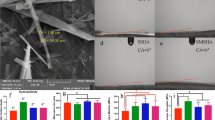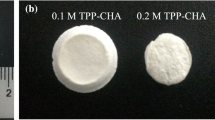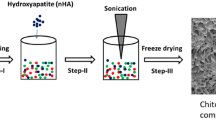Abstract
The current study involves fabrication and characterization of HA scaffolds containing different copper (Cu) content by ion exchange and 3D extrusion deposition technique. The fabricated pure HA and Cu-doped scaffolds (Cu–HA) were characterized by mechanical behavior, SEM, EDS, XRD, and FT-IR studies. The results show that the Cu-doped HA scaffolds show stronger compressive strength. In addition, the antibacterial properties and biological properties of these scaffolds were investigated in vitro. The antibacterial test results show that the addition of Cu in the HA scaffolds increased antibacterial activity, and the antibacterial properties of scaffolds significantly increased with the addition of Cu. The biocompatibility test results show that the 15Cu–HA scaffolds treated with 15% CuSO4 curing solution significantly inhibited of cell growth on day 7, while the 5Cu–HA scaffolds treated with 5% CuSO4 curing solution the cells observed good grown state on day 7. The 5Cu–HA scaffolds show stronger mechanical behavior, increased antibacterial properties and lower toxicity rat bone marrow mesenchymal stem cells (BMSCs) on day 7. So, the developed 5Cu–HA scaffolds can be used as a good biomaterial for bone tissue engineering.

Highlights
-
Copper was successfully doped into hydroxyapatite (HA) scaffolds using copper sulfate as a cross-linking agent.
-
Cu–HA scaffolds possessed good antibacterial activity and had no toxicity towards rat bone marrow mesenchymal stem cells (BMSCs) at low concentrations.










Similar content being viewed by others
References
Vallet-Regí M (2001) Ceramics for medical applications. J Chem Soc, Dalton Trans 2:97–108
Vallet-Regí M, González-Calbet JM (2004) Calcium phosphates as substitution of bone tissues. Progress in Solid State Chemistry 32(1):1–31. https://doi.org/10.1016/j.progsolidstchem.2004.07.001
Li Y, Ho J, Ooi CP (2010) Antibacterial efficacy and cytotoxicity studies of copper (II) and titanium (IV) substituted hydroxyapatite nanoparticles. Mater Sci Eng C 30(8):1137–1144. https://doi.org/10.1016/j.msec.2010.06.011
Kim T, Feng QL, Kim J, Wu J, Wang H, Chen G, Cui F (1998) Antimicrobial effects of metal ions (Ag+, Cu2+, Zn2+) in hydroxyapatite. J Mater Sci Mater Med 9(3):129–134
Calasans-Maia M, Rossi AM, Dias EP, Santos SR, Áscoli F, Granjeiro JM Stimulatory effect on osseous repair of zinc-substituted hydroxyapatite: histological study in rabbit’s tibia. In: Key Engineering Materials, 2008. Trans Tech Publ, pp 1269–1272
Wang Q, Tang P, Ge X, Li P, Lv C, Wang M, Wang K, Fang L, Lu X (2018) Experimental and simulation studies of strontium/zinc-codoped hydroxyapatite porous scaffolds with excellent osteoinductivity and antibacterial activity. Applied Surface Science 462:118–126
Xu Z-L, Lei Y, Yin W-J, Chen Y-X, Ke Q-F, Guo Y-P, Zhang C-Q (2016) Enhanced antibacterial activity and osteoinductivity of Ag-loaded strontium hydroxyapatite/chitosan porous scaffolds for bone tissue engineering. J Mate Chem B 4(48):7919–7928
Lei Y, Xu Z, Ke Q, Yin W, Chen Y, Zhang C, Guo Y (2017) Strontium hydroxyapatite/chitosan nanohybrid scaffolds with enhanced osteoinductivity for bone tissue engineering. Mater Sci Eng C 72:134–142
Fraga CG (2005) Relevance, essentiality and toxicity of trace elements in human health. Mol Aspects Med 26(4):235–244. https://doi.org/10.1016/j.mam.2005.07.013
Hu GF (1998) Copper stimulates proliferation of human endothelial cells under culture. J Cell Biochem 69(3):326–335
Rodríguez JP, Rios S, Gonzalez M (2002) Modulation of the proliferation and differentiation of human mesenchymal stem cells by copper. J Cell Biochem 85(1):92–100
Zhang J, Huang J, Xu S, Wang K, Yu S (2003) Effects of Cu2+ and pH on osteoclastic bone resorption in vitro. Prog Nat Sci 13(4):266–270
Kothapalli CR, Ramamurthi A (2009) Copper nanoparticle cues for biomimetic cellular assembly of crosslinked elastin fibers. Acta Biomater. 5(2):541–553
Strause L, Saltman P, Glowacki J (1987) The effect of deficiencies of manganese and copper on osteoinduction and on resorption of bone particles in rats. Calcif Tissue Int 41(3):145–150
Sakuma S, Atsumi K, Fujita K (1991) Antimicrobial hydroxyapatite powders and methods for preparing them. US Patent 5-009–898
Mehtar S, Wiid I, Todorov SD (2008) The antimicrobial activity of copper and copper alloys against nosocomial pathogens and Mycobacterium tuberculosis isolated from healthcare facilities in the Western Cape: an in-vitro study. J Hosp Infect 68(1):45–51. https://doi.org/10.1016/j.jhin.2007.10.009
Stanić V, Dimitrijević S, Antić-Stanković J, Mitrić M, Jokić B, Plećaš IB, Raičević S (2010) Synthesis, characterization and antimicrobial activity of copper and zinc-doped hydroxyapatite nanopowders. Appl Surf Sci 256(20):6083–6089
Pogosova MA, Kazin PE, Tretyakov YD (2012) Synthesis and characterisation of copper doped Ca–Li hydroxyapatite. Nucl Instrum Methods Phys Res Sec B Beam Interact Mater Atoms 284:33–35. https://doi.org/10.1016/j.nimb.2011.08.048
Li J, Li Y, Zuo Y (2006) Preparation and antibacterial properties valuation of copper-substituted nano-hydroxyapatite. J Funct Mater 37(4):635
Li J, Li Y, Zhang L, Zuo Y (2008) Composition of calcium deficient Na-containing carbonate hydroxyapatite modified with Cu (II) and Zn (II) ions. Appl Surf Sc 254(9):2844–2850
Chi W, Zou J, Ai F, Lin Y, Li W, Cao C, Yang K, Zhou K (2019) Research of Cu-doped hydroxyapatite microbeads fabricated by pneumatic extrusion printing. Materials 12 (11). https://doi.org/10.3390/ma12111769
Li T-T, Ling L, Lin M-C, Jiang Q, Lin Q, Lou C-W, Lin J-H (2019) Effects of ultrasonic treatment and current density on the properties of hydroxyapatite coating via electrodeposition and its in vitro biomineralization behavior. Mater Sci Eng C 105:110062. https://doi.org/10.1016/j.msec.2019.110062
Zhang CJ, Zhang NN, Wang Z, Zhu P (2011) Flame retardant properties of calcium alginate fibers. Dye Finish 8(1):1–5
Zhang J, Tanaka H, Ye F, Jiang D, Iwasa M (2007) Colloidal processing and sintering of hydroxyapatite. Mater Chem Phys 101(1):69–76. https://doi.org/10.1016/j.matchemphys.2006.02.016
Chi W, Zou J, Ai F, Lin Y, Li W, Cao C, Yang K, Zhou K (2019) Research of Cu-doped hydroxyapatite microbeads fabricated by pneumatic extrusion printing. Materials 12(11):1769
Misono M, Hall WK (1973) Oxidation-reduction properties of copper-and nickel-substituted hydroxyapatites. J Phys Chem 77(6):791–800
Webster TJ, Massa-Schlueter EA, Smith JL, Slamovich EB (2004) Osteoblast response to hydroxyapatite doped with divalent and trivalent cations. Biomaterials 25(11):2111–2121. https://doi.org/10.1016/j.biomaterials.2003.09.001
Sutter B, Ming D, Clearfield A, Hossner L (2003) Mineralogical and chemical characterization of iron-, manganese-, and copper-containing synthetic hydroxyapatites. Soil Sci Soc Am J 67(6):1935–1942
Hu W, Ma J, Wang J, Zhang S (2012) Fine structure study on low concentration zinc substituted hydroxyapatite nanoparticles. Mater Sci Eng C 32(8):2404–2410. https://doi.org/10.1016/j.msec.2012.07.014
Imrie F, Skakle J, Gibson I (2013) Preparation of copper-doped hydroxyapatite with varying x in the composition Ca10 (PO4) 6CuxOyHz. Bioceram Dev Appl S 1:2013
Zykin MA, Vasiliev AV, Trusov LA, Dinnebier RE, Jansen M, Kazin PE (2018) Solid state solubility of copper oxides in hydroxyapatite. J Solid State Chemistry 262:38–43
Baikie T, Ng GM, Madhavi S, Pramana SS, Blake K, Elcombe M, White T (2009) The crystal chemistry of the alkaline-earth apatites A10(PO4)6CuxOy(H)z(A=Ca, Sr and Ba). Dalton Trans 34:6722–6726
Shanmugam S, Gopal B (2014) Copper substituted hydroxyapatite and fluorapatite: synthesis, characterization and antimicrobial properties. Ceramics International 40(10, Part A):15655–15662. https://doi.org/10.1016/j.ceramint.2014.07.086
Joris S, Amberg C (1971) Nature of deficiency in nonstoichiometric hydroxyapatites. II. Spectroscopic studies of calcium and strontium hydroxyapatites. J Phys Chem 75(20):3172–3178
Yasukawa A, Higashijima M, Kandori K, Ishikawa T (2005) Preparation and characterization of cadmium–calcium hydroxyapatite solid solution particles. Colloids Surf A Physicochem Eng Asp 268(1–3):111–117
Wang H, Zhao S, Xiao W, Xue J, Shen Y, Zhou J, Huang W, Rahaman MN, Zhang C, Wang D (2016) Influence of Cu doping in borosilicate bioactive glass and the properties of its derived scaffolds. Mater Sci Eng C 58:194–203
Rutkowski P (2012) Catalytic effects of copper (II) chloride and aluminum chloride on the pyrolytic behavior of cellulose. J Anal Appl Pyrolysis 98:86–97
Fu Q, Rahaman MN, Fu H, Liu X (2010) Silicate, borosilicate, and borate bioactive glass scaffolds with controllable degradation rate for bone tissue engineering applications. I. Preparation and in vitro degradation. J Biomed Mater Res Part A 95(1):164–171
Othmani M, Bachoua H, Ghandour Y, Aissa A, Debbabi M (2018) Synthesis, characterization and catalytic properties of copper-substituted hydroxyapatite nanocrystals. Mater Res Bull 97:560–566. https://doi.org/10.1016/j.materresbull.2017.09.056
Santo CE, Lam EW, Elowsky CG, Quaranta D, Domaille DW, Chang CJ, Grass G (2011) Bacterial killing by dry metallic copper surfaces. Appl Environ Microbiol 77(3):794–802
Yasuyuki M, Kunihiro K, Kurissery S, Kanavillil N, Sato Y, Kikuchi Y (2010) Antibacterial properties of nine pure metals: a laboratory study using Staphylococcus aureus and Escherichia coli. Biofouling 26(7):851–858. https://doi.org/10.1080/08927014.2010.527000
Sahithi K, Swetha M, Prabaharan M, Moorthi A, Saranya N, Ramasamy K, Srinivasan N, Partridge N, Selvamurugan N (2010) Synthesis and characterization of nanoscalehydroxyapatite-copper for antimicrobial activity towards bone tissue engineering applications. J Biomed Nanotechnol 6(4):333–339
Swetha M, Sahithi K, Moorthi A, Saranya N, Saravanan S, Ramasamy K, Srinivasan N, Selvamurugan N (2012) Synthesis, characterization, and antimicrobial activity of nano-hydroxyapatite-zinc for bone tissue engineering applications. J Nanosci Nanotechnol 12(1):167–172
Li Y, Wang J, Wang Y, Du W, Wang S (2018) Transplantation of copper-doped calcium polyphosphate scaffolds combined with copper (II) preconditioned bone marrow mesenchymal stem cells for bone defect repair. J Biomater Appl 32(6):738–753. https://doi.org/10.1177/0885328217739456
Ingle AP, Duran N, Rai M (2014) Bioactivity, mechanism of action, and cytotoxicity of copper-based nanoparticles: a review. Appl Microbiol Biotechnol 98(3):1001–1009. https://doi.org/10.1007/s00253-013-5422-8
Acknowledgements
This work was supported by Key Laboratory of Lightweight and high strength structural materials of Jiangxi Province (No. 20171BCD40003) and Nanchang Municipal Key Laboratory of 3D Bioprinting Technology and Equipment (No. 2019NCZDSY001); China Scholarship Council (No. 201808360279 to KZ); China Postdoctoral Science Foundation (No. 2017M610402 to FA); Postdoctoral Science Foundation of Jiangxi Province (No. 2017KY06 to FA).
Author information
Authors and Affiliations
Corresponding author
Ethics declarations
Conflict of interest
The authors declare that they have no conflict of interest.
Additional information
Publisher’s note Springer Nature remains neutral with regard to jurisdictional claims in published maps and institutional affiliations.
Rights and permissions
About this article
Cite this article
Ai, F., Chen, L., Yan, J. et al. Hydroxyapatite scaffolds containing copper for bone tissue engineering. J Sol-Gel Sci Technol 95, 168–179 (2020). https://doi.org/10.1007/s10971-020-05285-0
Received:
Accepted:
Published:
Issue Date:
DOI: https://doi.org/10.1007/s10971-020-05285-0




